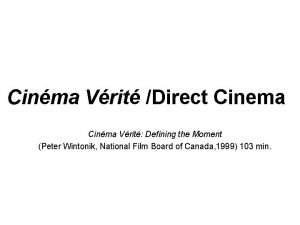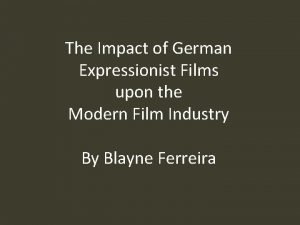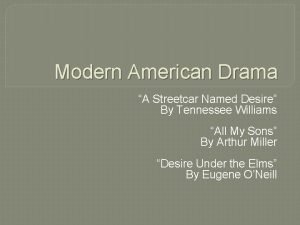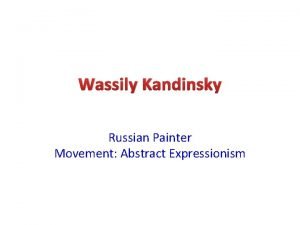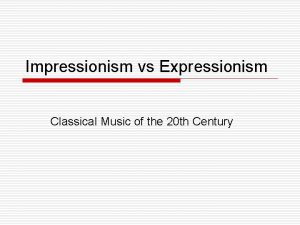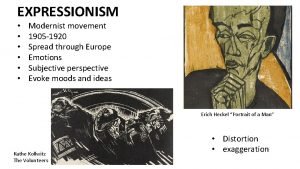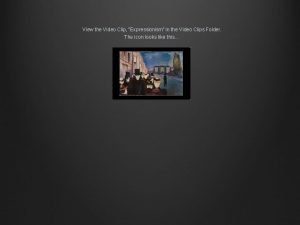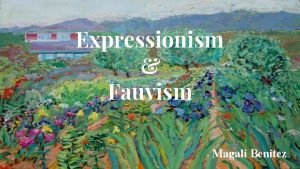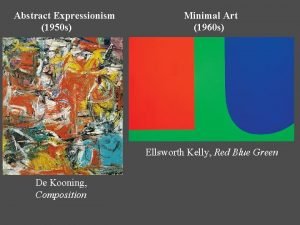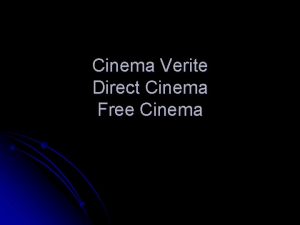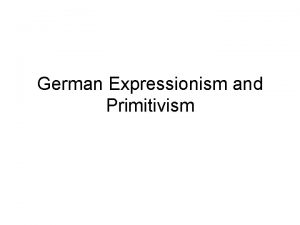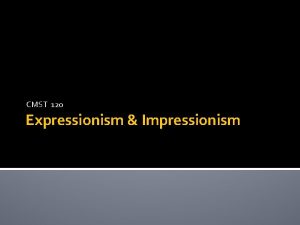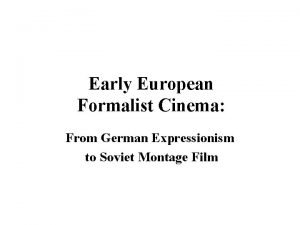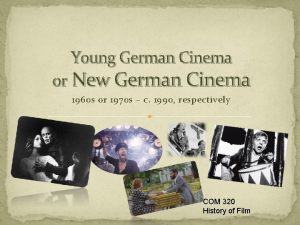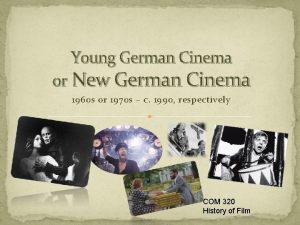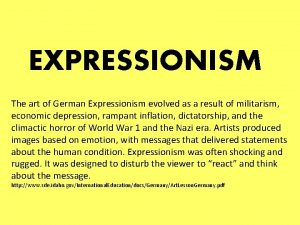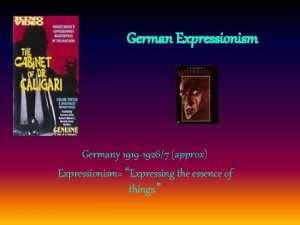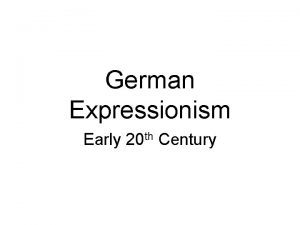German Expressionism cinema German expressionism was an early












- Slides: 12

German Expressionism cinema German expressionism was an early twentieth century German art movement that emphasized the artist's inner feelings or ideas over replicating reality, and was characterised by simplified shapes, bright colours and gestural marks or brushstrokes.

When did it start? �German expressionism started before the first world war and peaked in the 1920 s �It is said that in the history of films, German expressionism filmed the reality of daily life. The films and the art of the expressionist period represented the gruesome truth that the people of Germany dealt with. The period of expressionism is also called Weimar period in the film history that captured the emotions and sufferings of the broken nation and its people �s an extension of Avant-Garde movement, German expressionism started with the influence in art and painting where the “expression” was used as a style to narrate their society.

Where did it start? �German Expressionism is an artistic genre that originated in Europe in the 1920 s, and is broadly defined as the rejection of Western conventions, and the depiction of reality that is widely distorted for emotional effect �The German Expressionists were artists, writers, and thinkers who were of age in Germany prior to World War II, and lived during Wilhelm II's reign. German Expressionism developed as a result of the younger generation's reaction against the bourgeois culture of Germany during this time period.

How did it start? �German Expressionism developed as a result of the younger generation’s reaction against the bourgeois culture of Germany during this time period. �The German Expressionist movement was initially confined to Germany due to the isolation the country experienced during World War I. In 1916, the government had banned foreign films. The demand from theaters to generate films led to an increase in domestic film production from 24 films in 1914 to 130 films in 1918. With inflation also on the rise, Germans were attending films more freely because they knew that their money's value was constantly diminishing.

Key films from this era �The Cabinet of Dr. Caligari (1920)- he Cabinet of Dr. Caligari is justly famed for the skewed, anxiety-inducing angles of its painted backdrops, and for the nightmarish tension of its macabre storyline. �Nosferatu (1922)- Nosferatu makes extensive use of realworld locations, rather than recreating its world solely within a studio. �Variety (1925)- Variety is a melodrama with Expressionist touches, far removed from the Grand Guignol flavoring of the Expressionist horror cycle.

Video clips from key films from the era �Metropolis (1927) trailer - https: //youtu. be/gdt. Zv 3 XROnc �Nosferatu (1922) - https: //youtu. be/FC 6 j. Fo. Ym 3 xs �Faust (1926) - https: //youtu. be/ha 3 k_lts. WV 4 �The Last Laugh (1924) - https: //youtu. be/W 7 yi. ZM-Slw. I �Warning Shadows (1923) - https: //youtu. be/ki 3 Gr. Uk. L 26 g

Key film directors from the era �Robert Reinert (Nerves, 1919) �Fritz Lang (Metropolis, 1927) �Lupu Pick �Hans Werckmeister �Robert Weine �Karl Heinz Martin

Who were the biggest ‘stars’ of the era? �F. W. Mumau �Fritz Langt �Robert Wiene �Paul Wegner �Paul Leni �Georg Kaiser �Erich Pommer

Which genres were the most popular? �Surrealism �Symbolism �Abstract Art �Science Fiction �Horror �Inner Conflict �Psychological �Distortion of reality

What film styles/techniques did this era create? Expressionism used mise-en-scene and heavy atmosphere Long shadow effects Artificial sets with realistic details The details in the sets bring forth the emotional, that stirs audience mind Camera set in unexpected angles gives audience a different perception Aims in evoking mystery, hallucinations and extreme emotional stress Slow pace than other regular movies High angles. Deep shadows/chiaroscuro lighting. Extreme camera tilting. Impossible sets. The films made were surreal, distorted with heavy shadows to make the story look gloomy and depressing � Film makers deliberately distorted everything within the frame so it was all designed to look deliberately artificial and throw you off balance. This highly subjective cinematic sensibility � � �

What are the biggest box office successes of the era? - Top 10 1. 2. 3. 4. 5. 6. 7. 8. 9. 10. Ben-Hur: A Tale of the Christ (1925) The Big Parade (1925) The Singing Fool (1928) The Birth of a Nation (1915) Napoleon (1927, Fr. ) (aka Napoléon vu par Abel Gance) The Four Horsemen of the Apocalypse (1921) Something to Think About (1920) Twenty Thousand Leagues Under the Sea (1916) Mickey (1918) The Covered Wagon (1923)

Why did the silent part of this era end? What was the first ‘talkie’ in this movement? � German expressionism came to an end in 1923 with political barriers and forced ban � Expressionism was thought to be a degenerated art for film making in Germany. � German expressionists moved to Hollywood where expressionism continued with the influence of Hollywood glamour and culture. It is considered that the main reason for the fade away of Expressionism was the gradual disinterest in the topic. � The movement ended after the currency stabilized, making it cheaper to buy movies abroad. � German studios began to deal with Italian studios which led to their influence in style of horror and films noir. � The first feature film originally presented as a talkie was The Jazz Singer, which premiered on October 6, 1927.
 La vrit
La vrit Blade runner german expressionism
Blade runner german expressionism Low german vs high german
Low german vs high german Early cpr and early defibrillation can: *
Early cpr and early defibrillation can: * Expressionist theatre streetcar named desire
Expressionist theatre streetcar named desire Expressionism death of a salesman
Expressionism death of a salesman Russian painter abstract
Russian painter abstract Expressionism vs impressionism
Expressionism vs impressionism Die brucke manifesto
Die brucke manifesto Expressionism video
Expressionism video Impressionism vs expressionism
Impressionism vs expressionism Magali benitez
Magali benitez Minimal art 1960
Minimal art 1960
